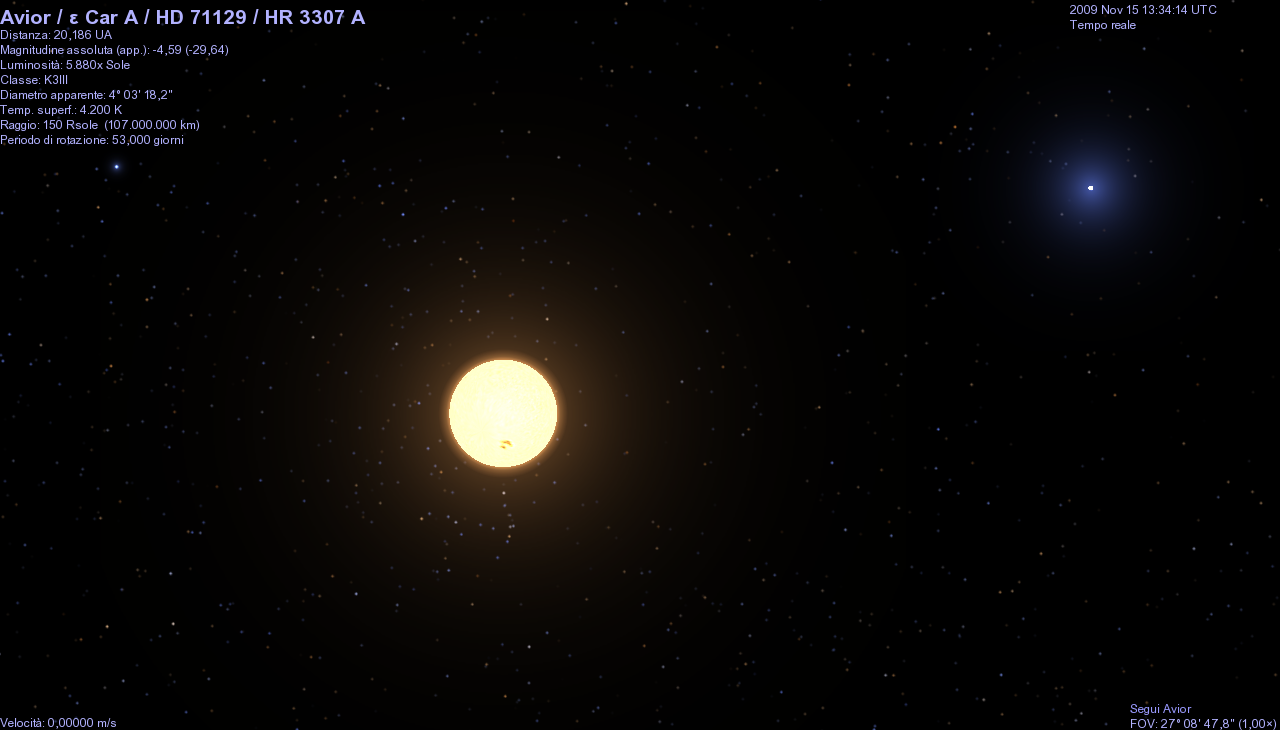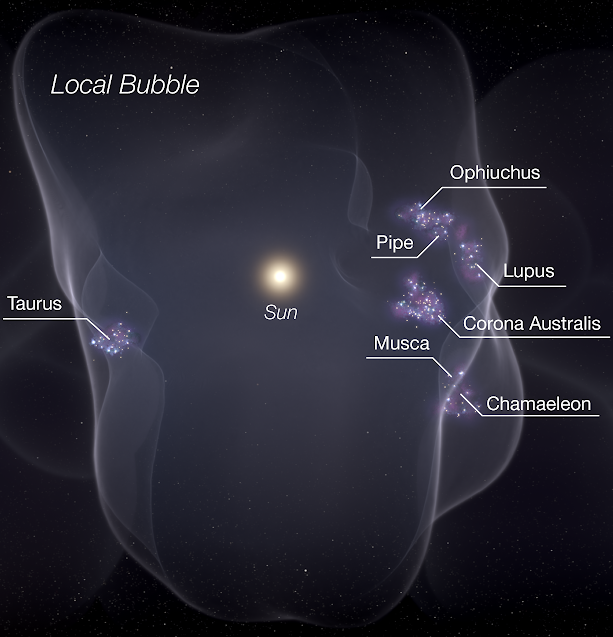|
V686 Coronae Australis
V686 Coronae Australis (HD 175362; HR 7129; V686 CrA) is a solitary, bluish-white-hued variable star located in the southern constellation Corona Australis. It has an apparent magnitude that ranges between 5.25 and 5.41, which makes it faintly visible to the naked eye. Gaia DR3 parallax measurements imply a distance of 480 light years and it is slowly receding with a heliocentric radial velocity of . At its current distance V686 CrA's average brightness is diminished by 0.35 magnitudes due to extinction from interstellar dust and it has an absolute visual magnitude of −0.24. V686 CrA has been known to be variable since 1974. The discovery paper lists it as a helium variable with a period of 3.71 days. Earlier sources give it ordinary spectral classes such as B7.5 V, B8 IV. and B9 III:. In 1976, V686 CrA was found to have a large magnetic field ranging from −5,000 gauss to 7,000 gauss. Borra et al. (1983) gave a value of gauss. A catalogue of chemically peculiar s ... [...More Info...] [...Related Items...] OR: [Wikipedia] [Google] [Baidu] |
Variable Star Designation
In astronomy, a variable star designation is a unique identifier given to variable stars. It uses a variation on the Bayer designation format, with an identifying label (as described below) preceding the Latin genitive of the name of the constellation in which the star lies. See List of constellations for a list of constellations and the genitive forms of their names. The identifying label can be one or two Latin letters or a ''V'' plus a number (e.g. V399). Examples are R Coronae Borealis, YZ Ceti, V603 Aquilae. Naming The current naming system is: *Stars with existing Greek letter Bayer designations are not given new designations. *Otherwise, start with the letter R and go through Z. *Continue with RR...RZ, then use SS...SZ, TT...TZ and so on until ZZ. *Use AA...AZ, BB...BZ, CC...CZ and so on until reaching QZ, omitting J in both the first and second positions.Most of this system was invented in Germany, which was still on Fraktur at the time, in which the majuscules "I" a ... [...More Info...] [...Related Items...] OR: [Wikipedia] [Google] [Baidu] |
Helium Variable
SX Arietis variables are a class of variable stars. They are generally B-type main sequence stars of spectral types B0p to B9p— high-temperature analogues of Alpha2 Canum Venaticorum variables—and exhibit strong magnetic fields and intense He I and Si III spectral lines. They have brightness fluctuations of approximately 0.1 magnitudes with periods of about one day. The prototype of this class is 56 Arietis, which bears the variable star designation In astronomy, a variable star designation is a unique identifier given to variable stars. It uses a variation on the Bayer designation format, with an identifying label (as described below) preceding the Latin genitive of the name of the constell ... ''SX Arietis''. List The following list contains selected SX Arietis variable that are of interest to amateur or professional astronomy. Unless otherwise noted, the given magnitudes are in the V-band. Notes References Samus N.N., Durlevich O.V., et al. ''Combined G ... [...More Info...] [...Related Items...] OR: [Wikipedia] [Google] [Baidu] |
Luminosity Of The Sun
The solar luminosity (), is a unit of radiant flux ( power emitted in the form of photons) conventionally used by astronomers to measure the luminosity of stars, galaxies and other celestial objects in terms of the output of the Sun. One nominal solar luminosity is defined by the International Astronomical Union to be . This does not include the solar neutrino luminosity, which would add , or , i.e. a total of (the mean energy of the solar photons is 26 MeV and that of the solar neutrinos 0.59 MeV, i.e. 2.27%; the Sun emits photons and as many neutrinos each second, of which per m2 reach the Earth each second). The Sun is a weakly variable star, and its actual luminosity therefore fluctuates. The major fluctuation is the eleven-year solar cycle (sunspot cycle) that causes a quasi-periodic variation of about ±0.1%. Other variations over the last 200–300 years are thought to be much smaller than this. Determination Solar luminosity is related to solar irradiance (the so ... [...More Info...] [...Related Items...] OR: [Wikipedia] [Google] [Baidu] |
Mass Of The Sun
The solar mass () is a standard unit of mass in astronomy, equal to approximately . It is often used to indicate the masses of other stars, as well as stellar clusters, nebulae, galaxies and black holes. It is approximately equal to the mass of the Sun. This equates to about two nonillion ( short scale), two quintillion (long scale) kilograms or 2000 quettagrams: The solar mass is about times the mass of Earth (), or times the mass of Jupiter (). History of measurement The value of the gravitational constant was first derived from measurements that were made by Henry Cavendish in 1798 with a torsion balance. The value he obtained differs by only 1% from the modern value, but was not as precise. The diurnal parallax of the Sun was accurately measured during the transits of Venus in 1761 and 1769, yielding a value of (9 arcseconds, compared to the present value of ). From the value of the diurnal parallax, one can determine the distance to the Sun from the geometry ... [...More Info...] [...Related Items...] OR: [Wikipedia] [Google] [Baidu] |
B-type Star
A B-type main-sequence star (B V) is a main-sequence (hydrogen-burning) star of spectral type B and luminosity class V. These stars have from 2 to 16 times the mass of the Sun and surface temperatures between 10,000 and 30,000 K. B-type stars are extremely luminous and blue. Their spectra have neutral helium, which are most prominent at the B2 subclass, and moderate hydrogen lines. Examples include Regulus and Algol A. This class of stars was introduced with the Harvard sequence of stellar spectra and published in the ''Revised Harvard photometry'' catalogue. The definition of type B-type stars was the presence of non-ionized helium lines with the absence of singly ionized helium in the blue-violet portion of the spectrum. All of the spectral classes, including the B type, were subdivided with a numerical suffix that indicated the degree to which they approached the next classification. Thus B2 is 1/5 of the way from type B (or B0) to type A. Later, however, more refined sp ... [...More Info...] [...Related Items...] OR: [Wikipedia] [Google] [Baidu] |
Stellar Classification
In astronomy, stellar classification is the classification of stars based on their spectral characteristics. Electromagnetic radiation from the star is analyzed by splitting it with a prism or diffraction grating into a spectrum exhibiting the rainbow of colors interspersed with spectral lines. Each line indicates a particular chemical element or molecule, with the line strength indicating the abundance of that element. The strengths of the different spectral lines vary mainly due to the temperature of the photosphere, although in some cases there are true abundance differences. The ''spectral class'' of a star is a short code primarily summarizing the ionization state, giving an objective measure of the photosphere's temperature. Most stars are currently classified under the Morgan–Keenan (MK) system using the letters ''O'', ''B'', ''A'', ''F'', ''G'', ''K'', and ''M'', a sequence from the hottest (''O'' type) to the coolest (''M'' type). Each letter class is then subdivi ... [...More Info...] [...Related Items...] OR: [Wikipedia] [Google] [Baidu] |
Local Association
The Local Bubble, or Local Cavity, is a relative cavity in the interstellar medium In astronomy, the interstellar medium is the matter and radiation that exist in the space between the star systems in a galaxy. This matter includes gas in ionic, atomic, and molecular form, as well as dust and cosmic rays. It fills interstella ... (ISM) of the Orion Arm in the Milky Way. It contains the List of nearest stars and brown dwarfs, closest of celestial neighbours and among others, the Local Interstellar Cloud (which contains the Solar System), the neighbouring G-Cloud, the Ursa Major Moving Group (List of nearby stellar associations and moving groups, the closest stellar Stellar kinematics#moving group, moving group) and the Hyades (star cluster), Hyades (the nearest open cluster). It is at least 300 light years across, and is defined by its neutral-hydrogen density of about 0.05 atoms/cm3, or approximately one tenth of the average for the ISM in the Milky Way (0.5 a ... [...More Info...] [...Related Items...] OR: [Wikipedia] [Google] [Baidu] |
Mercury-manganese Star
A mercury-manganese star (also HgMn star) is a type of chemically peculiar star with a prominent spectral line at 398.4 nm, due to absorption from ionized mercury. These stars are of spectral type B8, B9, or A0, corresponding to surface temperatures between about 10,000 and 15,000 K, with two distinctive characteristics: * An atmospheric excess of elements like phosphorus, manganese, gallium, strontium, yttrium, zirconium, platinum and mercury. * A lack of a strong dipole magnetic field. Their rotation is relatively slow, and as a consequence their atmosphere is relatively calm. It is thought, but has not been proven, that some types of atoms Every atom is composed of a nucleus and one or more electrons bound to the nucleus. The nucleus is made of one or more protons and a number of neutrons. Only the most common variety of hydrogen has no neutrons. Every solid, liquid, gas, an ... sink under the force of gravity, while others are lifted towards the exterior of ... [...More Info...] [...Related Items...] OR: [Wikipedia] [Google] [Baidu] |
Helium-weak Star
Helium-weak stars are chemically peculiar stars which have a weak helium lines for their spectral type. Their helium lines place them in a later (i.e. cooler) spectral type then their hydrogen lines. List of helium-weak stars This is a non-extensive list of helium-weak stars. Helium-strong star A related class of stars have anomalously strong helium lines in their spectra, and are known as helium-strong stars. See also * Helium star * Extreme helium star An extreme helium star (abbreviated EHe) is a low-mass supergiant that is almost devoid of hydrogen, the most common chemical element of the Universe. Since there are no known conditions where stars devoid of hydrogen can be formed from molecular c ... References Star types {{stellar-astronomy-stub ... [...More Info...] [...Related Items...] OR: [Wikipedia] [Google] [Baidu] |



